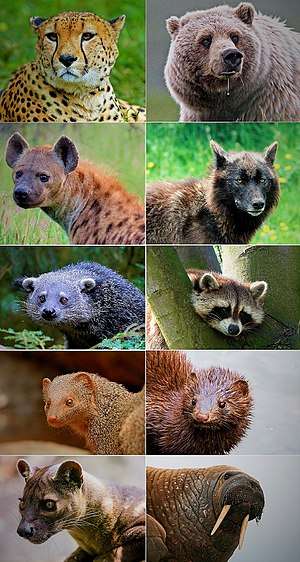Carnivoramorpha
Carnivoramorpha are a clade of mammals that includes the modern order Carnivora.
| Carnivoramorpha | |
|---|---|
 | |
| Scientific classification | |
| Kingdom: | Animalia |
| Phylum: | Chordata |
| Class: | Mammalia |
| Clade: | Ferae |
| Clade: | Carnivoramorpha |
| Subgroups | |
|
| |

Classification and phylogeny
Traditional classification
- Clade Carnivoramorpha (basal to Carnivora but without Creodonts)
- Superfamily †Miacoidea
- Family †Miacidae
- genera: Chailicyon, Eosictis, Miacis, Miocyon, Oodectes, Palaearctonyx, Paramiacis, Paroodectes, Prodaphaenus, Quercygale, Tapocyon, Uintacyon, Vassacyon, Vulpavus, Xinyuictis
- Family †Viverravidae
- genera: Bryanictis, Didymictis, Ictidopappus, Palaeogale, Pappidictops, Pristinictis, Protictis, Raphictis, Simpsonictis, Viverravus
- Family †Miacidae
- Order Carnivora
- Suborder Caniformia (or Canoidea)
- Suborder Feliformia (or Feloidea)
- Superfamily †Miacoidea
Revised classification
As phylogenetic studies indicate that the superfamily Miacoidea is paraphyletic, with miacids being more closely related to carnivorans than to viverravids, Flynn, Finarelli & Spaulding (2010) named a new clade within Carnivoramorpha, Carnivoraformes, containing carnivorans and miacids but not viverravids; the authors defined Carnivoraformes as the clade containing Carnivora and all taxa that are more closely related to Carnivora (represented by Canis lupus) than to Viverravus gracilis.
- Clade: Carnivoramorpha
- Genus: †Ravenictis
- Family: †Viverravidae
- Clade: Carnivoraformes
- Genus: †Ceruttia
- Genus: †Dawsonicyon
- Genus: †Miacis
- Genus: †Prodaphaenus
- Genus: †Walshius
- (unranked): Neovulpavus clade
- Genus: †Neovulpavus
- Incertae sedis:
- †"Miacis" medius
- (unranked): Oodectes clade
- Genus: †Eogale
- Genus: †Gracilocyon
- Genus: †Oodectes
- Genus: †Paramiacis
- Genus: †Paroodectes
- (unranked): Uintacyon clade
- Genus: †Miocyon
- Genus: †Simamphicyon
- Genus: †Uintacyon (including Xinyuictis)
- Genus: †Zodiocyon
- Incertae sedis:
- †"Miacis" invictus
- †"Miacis" lushiensis
- †"Miacis" thailandicus
- (unranked): Vulpavus clade
- Genus: †Dormaalocyon
- Genus: †Vassacyon
- Genus: †Vulpavus (including Palaearctonyx)
- Incertae sedis:
- †"Miacis" deutschi
- †"Miacis" exiguus
- Incertae sedis:
- †"Miacis" boqinghensis
- †"Miacis" hookwayi
- †"Miacis" latidens
- †"Miacis" petilus
- †"Miacis" vulpinus
- Order: Carnivora
- Suborder: Caniformia ("dog-like" carnivorans)
- Suborder: Feliformia ("cat-like" carnivorans)
Phylogenetic tree
The phylogenetic relationships of Carnivoramorpha are shown in the following cladogram:[1][2][3][4][5][6][7][8][9][10]
| Ferae |
| ||||||||||||||||||||||||||||||||||||||||||||||||||||||||||||||||||||||||||||||||||||||||||||||||||||||||||||||||||||||||||||||||||||||||||||||||||||||||||||||||||||||||||||||||||||||||||||||||||||||||||||||||||||||||||||||||||||||||||||||||||||||||||||||||||||||
References
- Bryant, H.N., and M. Wolson (2004) “Phylogenetic Nomenclature of Carnivoran Mammals.” First International Phylogenetic Nomenclature Meeting. Paris, Museum National d’Histoire Naturelle
- John J. Flynn; John A. Finarelli; Michelle Spaulding (2010). "Phylogeny of the Carnivora and Carnivoramorpha, and the use of the fossil record to enhance understanding of evolutionary transformations". In Anjali Goswami; Anthony Friscia (eds.). Carnivoran evolution. New views on phylogeny, form and function. Cambridge University Press. pp. 25–63. doi:10.1017/CBO9781139193436.003. ISBN 9781139193436.
- Michelle Spaulding; John J. Flynn; Richard K. Stucky (2010). "A new basal Carnivoramorphan (Mammalia) from the 'Bridger B' (Black's Fork member, Bridger Formation, Bridgerian Nalma, middle Eocene) of Wyoming, USA". Palaeontology. 53 (4): 815–832. doi:10.1111/j.1475-4983.2010.00963.x.
- Susumu Tomiya (2011). "A new basal caniform (Mammalia: Carnivora) from the Middle Eocene of North America and remarks on the phylogeny of early carnivorans". PLOS One. 6 (9): e24146. doi:10.1371/journal.pone.0024146. PMC 3173397. PMID 21935380.
- Solé, Floréal; Smith, Richard; Coillot, Tiphaine; de Bast, Eric; Smith, Thierry (2014). "Dental and tarsal anatomy of Miacis latouri and a phylogenetic analysis of the earliest carnivoraforms (Mammalia, Carnivoramorpha)". Journal of Vertebrate Paleontology. 34 (1): 1–21. doi:10.1080/02724634.2013.793195. ISSN 0272-4634.
- Wang, Jian; Zhang, Zhaoqun (2015). "Phylogenetic analysis on Palaeogale (Palaeogalidae, Carnivora) based on specimens from Oligocene strata of Saint-Jacques, Nei Mongol". Vertebrata PalAsiatica. 53 (4): 310–334.
- Solé, Floréal; Smith, Thierry; De Bast, Eric; Codrea, Vlad; Gheerbrant, Emmanuel (2016). "New carnivoraforms from the latest Paleocene of Europe and their bearing on the origin and radiation of Carnivoraformes (Carnivoramorpha, Mammalia)". Journal of Vertebrate Paleontology. 36 (2): e1082480. doi:10.1080/02724634.2016.1082480. ISSN 0272-4634.
- Tomiya, Susumu; Tseng, Zhijie Jack (2016). "Whence the beardogs? Reappraisal of the Middle to Late Eocene 'Miacis' from Texas, USA, and the origin of Amphicyonidae (Mammalia, Carnivora)". Royal Society Open Science. 3 (10): 160518. Bibcode:2016RSOS....3p0518T. doi:10.1098/rsos.160518. ISSN 2054-5703. PMC 5098994. PMID 27853569.
- Solé, F. & Ladevèze, S. (2017). "Evolution of the hypercarnivorous dentition in mammals (Metatheria, Eutheria) and its bearing on the development of tribosphenic molars." Evolution & Development, 19(2), 56–68.
- Prevosti, F. J., & Forasiepi, A. M. (2018). "Introduction. Evolution of South American Mammalian Predators During the Cenozoic: Paleobiogeographic and Paleoenvironmental Contingencies"
- Archibold, J.D., and K.D. Rose (eds.). (2005). “The Rise of Placental Mammals: Origins and Relationships of the Major Clades.” Baltimore and London: The Johns Hopkins University Press. ISBN 0-8018-8022-X
- Archibold, J.D., and K.D. Rose. (2005). “Womb with a View: the Rise of Placentals.”
- Benton, Michael J. and Philip C.J. Donoghue. (2007). “Paleontological Evidence to Date the Tree of Life.” Dating the Tree of Life 31.
- Bryant, H.N., and M. Wolson (2004) “Phylogenetic Nomenclature of Carnivoran Mammals.” First International Phylogenetic Nomenclature Meeting. Paris, Museum National d’Histoire Naturelle, July 6–9, 2004.
- Flynn, John J. and Gina D. Wesley-Hunt. 2005. "Phylogeny of the Carnivora: Basal Relationships Among the Carnivoramorphans, and Assessment of the Position of 'Miacoidea' Relative to Carnivora." Journal of Systematic Palaeontology, 3: 1-28. Abstract:
- Haaramo, Mikko. (2005). “Mikko's Phylogeny Archive Carnivoramorpha - Carnivores and relatives.” Retrieved February 17, 2007, from:
- Stiles, David P. (2005). “An investigation of the Vulpes and Urocyon phylogenetic classification: Feliformia or Caniformia?” Fox Phylogeny. Vertebrate Evolution – Fall 2005, The Evergreen State College, Olympia, WA.
- Wesley-Hunt, Gina D. (2006). “The Morphological Diversification of Carnivores in North America.” Paleobiology. Vol. 31, Issue 1, pp. 35–55.
- Wyss, A. R. & Flynn, J. J. (1993). “A Phylogenetic Analysis and Definition of the Carnivora.” in Mammal Phylogeny – Placentals, Szalay, F.S., M.J. Novacek and M.C. McKenna (eds.). ISBN 0-387-97853-4.
- John J. Flynn; John A. Finarelli; Michelle Spaulding (2010). "Phylogeny of the Carnivora and Carnivoramorpha, and the use of the fossil record to enhance understanding of evolutionary transformations". In Anjali Goswami; Anthony Friscia (eds.). Carnivoran evolution. New views on phylogeny, form and function. Cambridge University Press. pp. 25–63. doi:10.1017/CBO9781139193436.003. ISBN 9781139193436.